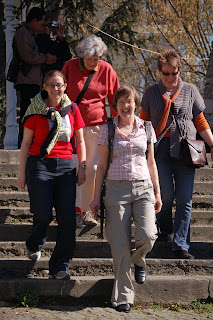On Monday, I returned to work after a wonderful break in Istanbul with family. I was so grateful for the warmth of the sun as well as for the beauty of the city, including its mosques and palaces. The photo above (of my mother, me, my sister-in-law and niece) may give you some sense of our sunshine and good cheer.
In between catching up in my office and generally getting stuck in, I found myself glued to radio and television following the death of Baroness Margaret Thatcher, a towering and iconic figure in British and indeed global politics, one who divided a nation – the Marmite of twentieth century politics in Britain. The hurt that some people still feel, especially in Britain’s former mining communities, is so great that some have lost sight of the basic human experience of bereavement and have openly celebrated her death.
I wonder if Britain’s current generation of beleaguered CEOs feels some empathy for the challenges Thatcher faced when she took on the leadership of the Conservative Party in 1975 and became Prime Minister in 1979. Many commentators in the last 48 hours have pointed to aspects of life in Britain in the 1970s as an important backdrop to understanding Thatcher’s role in British politics. Thatcher came to power at a time of economic turmoil and industrial unrest – bitter disputes between government and unions. In 1974, for example, having failed to win the battle with Britain’s coal-miners, the UK government imposed a three-day working week for commercial users of electricity. In 1979, Thatcher’s rise to power followed Britain’s “Winter of Discontent”, when fresh industrial action included action by dustmen which left rubbish piling up in the streets of London. The Conservative slogan Labour Isn’t Working struck a chord with voters who gave Thatcher a 44-seat majority in the 1979 general election. In 1979 Thatcher herself said she couldn’t bear Britain in decline.

As I write, I feel humble in the face of any commentary on Thatcher’s leadership which was, itself, controversial. Instead, I allow myself a few reflections on aspects of her leadership and compare them with what I see in some of today’s CEOs.
Vision and principles
As a leader, Thatcher’s approach was grounded in a vision of a more prosperous Britain and in her firm beliefs about what it might take to get there. True to her roots, she was able to extrapolate from her childhood as a grocer’s daughter and to understand that Britain needed to balance the books – a lesson that politicians and businessmen and women all over the world are currently and painfully having to learn again. Thatcher also took the view that the ideals of her socialist opponents were best fulfilled via prosperity for the country as a whole – that Britain could not fulfil its aspirations to care for those in need without, first, generating wealth.
Today, CEOs are having to refresh their vision for the organisations in their charge, stripping them back to a bare minimum. For clients I work with, this bare minimum includes core aims of the organisation and activities which support those aims. It also includes stripping away excess cost. It also includes managing risk and ensuring compliance with core external requirements. Stripping a vision back in this way creates clarity for organisations which have been or might otherwise be in crisis. The message is not always welcome and, nonetheless, it is clear.
Personal transformation
Thatcher’s steadfast adherence to her vision and underlying principles were such that, when Captain Yuri Gavrilov described her as an Iron Lady in 1976, the nickname stuck. At the same time, whilst steadfast in her political beliefs, Thatcher was the queen of personal transformation. Famously, she received vocal coaching from the National Theatre’s voice coach, lowering her voice to achieve greater gravitas and authority. Later, as aspiring leader and PM, Thatcher toned down her hair colour because she understood that her platinum blonde was too strident. Later still, her wardrobe was transformed under the direction of Margaret King, who became her stylist in 1987.
In the modern world of leadership, few CEOs would go to such lengths. Even so, the most effective leaders understand that whilst they need to promote a clear vision, they need to be flexible about the means to achieve their vision, adjusting their approach in the light of new information or to meet the needs of a specific situation. If their message is not getting across, they think about how to change their communication and influencing approach so that it can be more easily heard and understood.
Building a leadership team
Commentators note that when she became leader of the opposition in 1979, Thatcher’s cabinet was comprised entirely of the supporters of her exiled predecessor, Edward Heath. Her response was to quietly replace them, creating a new cabinet.
The new CEO always faces the challenge of legacy and has to manage a tricky balance in order to create an effective leadership team. The history that comes with the “old guard” can act as a barrier to change, even at the most senior levels. There may also be questions of capability – does the inherited team have the capability needed to achieve important goals for the organisation? At the same time, the old team often has a fair dose of organisational savvy – team members know how things get done around here. Bringing in new team members can create a time delay whilst “newbies” get up to speed and poor recruitment decisions can also impede progress. It takes great skill to proceed effectively as a new, incoming CEO.
Addressing the “enemy within”
Thatcher saw the unions as Britain’s “enemy within” and her most bitter opponents include many former miners and their relatives. She was concerned about the power held by union leaders which she saw as anti-democratic. She was also concerned about the impact on the nation’s economy of strike action. Two years after winning the Falklands War she took on the miners – and won.
In 21st century Britain, CEOs who have set tough challenges for their staff nonetheless seek to work with them to achieve their aims. Approaches like “LEAN” seek to maximise value whilst minimising waste. At its best, this approach exemplifies the distribution of roles and responsibilities: CEOs set targets for the organisation which are broken down for execution by leaders throughout the organisation. Leaders, in turn, work with their staff to identify ways to meet these targets. In the modern era the enemy within is more likely to be excess cost or bureaucracy than some powerful lobby of people.
Drawing on personal support
It’s lonely at the top. This phrase is no less true for being a well-worn cliche. Behind the scenes, Britain’s Prime Minister was supported by her loyal husband whom she described as “my Denis”. An article in the Independent told how Thatcher once said of her husband: “I couldn’t have done it without Denis. He was a fund of shrewd advice and penetrating comment. And he very sensibly saved these for me rather than the outside world. I think the marvellous thing is that he gives me a sense of perspective. If I am upset or think I have done something silly, we talk about it and he makes me see sense”.
In the modern era, people increasingly understand the need to have the right personal support. The modern CEO may well be supported by husband or wife or by others in his or her life who have been tested in long relationships – former colleagues, for example. Equally, support may come in the form of a well-chosen coach or mentor.
Leading by example
I may be wrong and still, “hypocrisy” is not a word I associate with Margaret Thatcher, nor one used by her detractors. A proponent of sound financial management in the country as a whole she is said to have practised great frugality in her official residence – Wikipedia notes that she even insisted on paying for her own ironing board. It is, perhaps, this congruity between speech and action that underlines the current fashion for “authentic leadership”.
In closing, I ask for your reflections on Margaret Thatcher’s leadership. What do you see as her greatest strengths in the role of leader? I also pause to remember with compassion the human being – the woman – who has been lost to her family.









